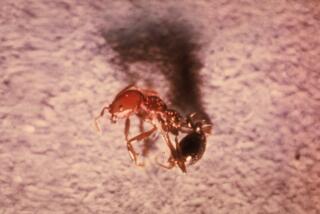Pesky Fire Ant Defies Eradication Efforts
- Share via
TIFTON, Ga. — Farmers and homeowners perhaps should just learn to live with the fire ant, says a researcher who has been unable to find a way to get rid of the imported pest with the painful and sometimes deadly sting.
“With today’s technology, there’s nothing out there that’ll eradicate them,” said Stan Diffie of the University of Georgia’s Coastal Plain Experiment Station. “We can control them, but we can’t eradicate them.”
Diffie and entomologist Craig Sheppard have been evaluating chemical and biological methods of controlling the South American insect, believed to have entered the United States at Mobile, Ala., about 60 years ago. Fire ants have since colonized 270 million acres of the Carolinas, Puerto Rico, Oklahoma, Florida, Georgia, Alabama, Louisiana, Mississippi, Texas and Arkansas.
Fire ants reproduce quickly and spread rapidly. In south Georgia, it’s not uncommon to find 40 mounds per acre. In fields where farm machinery is used “you would have a problem,” Diffie said.
“They’re a nuisance--a people pest, whether it’s unsightliness in your yard or stinging your kids,” said Diffie. The ant’s painful sting causes at least 21,000 people to seek medical treatment each year, according to a survey of physicians in 13 states for the American Academy of Allergy and Immunology.
Last year, 32 people died from fire ant stings, most of them individuals especially sensitive to the toxin who were bitten more than once. Nearly 40% of those treated were in Texas, according to the survey, and 20% were in Florida. “People and physicians should take these stings seriously,” said Dr. Robert Rhoades, a pediatrician at the Medical College of Georgia who monitors medical problems caused by fire ants. People who are allergic to other insects’ stings should be especially cautious. The stings cause a burning sensation usually followed by formation of pus around the site within 24 hours.
Fire ants also help farmers by attacking ticks, worms and other insects that damage sugar cane, cotton and pecan trees. Each mound houses up to 250,000 ants and may cover an excavation six feet deep. They also are effective scavengers.
“They’ll eat anything that’s dead (and) you have to have something out there to clean up the carcasses,” Diffie said.
In the search for effective controls, Diffie has studied baits, pesticides and natural enemies such as nematodes and mites. He makes bait from corn grits soaked in soybean oil and poison and scatters it on pastures and fields, where the fire ants carry into their mounds.
Only a few ants in each colony are capable of reproduction. The fertile males and females have wings and mate in flight. Then the males die and the females establish new colonies. “You have got to kill the queen,” Diffie said. “If you don’t, she’ll just keep laying eggs.”
Common pesticides can kill fire ants, but don’t remain active in the soil long enough to be a long-term solution, he said. “It would be nice if we could put them where we want them--get them out of the yard and put them in the pecan orchards and sugar cane fields--but I’d rather see them gone altogether. If we didn’t have them, we’d find ways to control the other pests.”
Concern about environmental hazards has led researchers to look for biological controls, such as microscopic worms known as nematodes and straw-itch mites, which are a natural enemy of fire ants.
“Nematodes were mixed in water and poured over a fire ant mound. About 2 million nematodes could be mixed in two gallons of water,” Diffie said. Those tests weren’t considered very successful, because only about 37% of the colonies treated with nematodes were destroyed.
Mites trials were “fairly successful,” he said, “but the cost is prohibitive, as treatments are $5 per mound and two treatments are necessary.”
More to Read
Sign up for Essential California
The most important California stories and recommendations in your inbox every morning.
You may occasionally receive promotional content from the Los Angeles Times.








